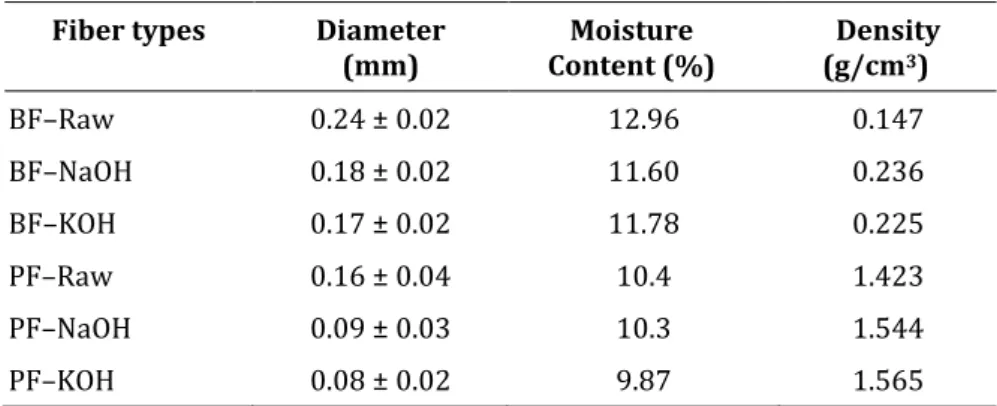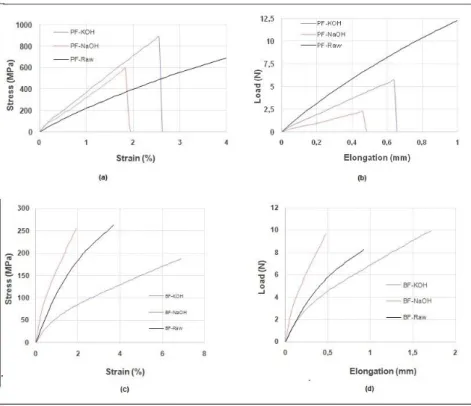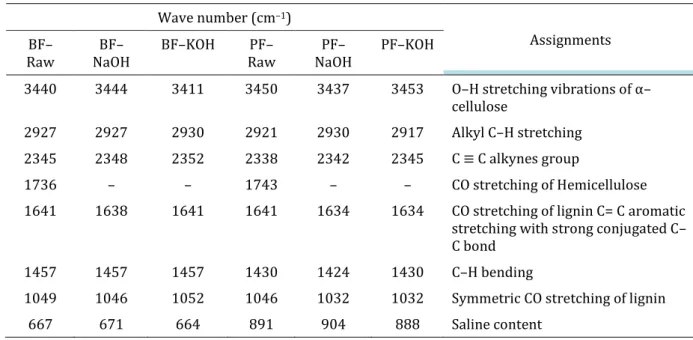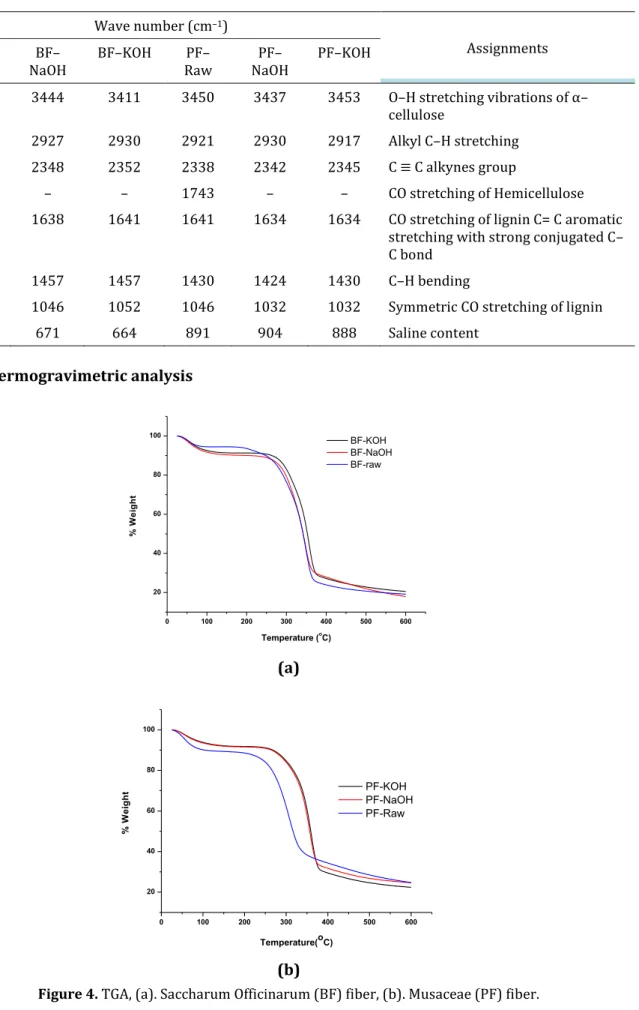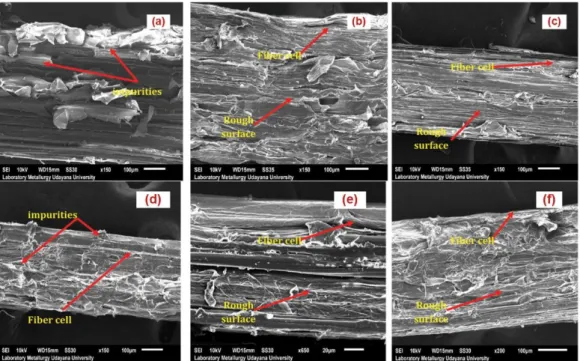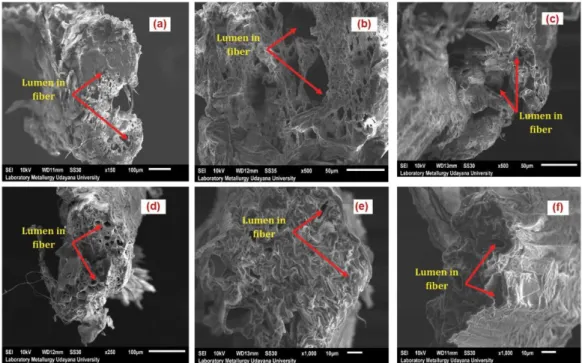The properties of natural fibers depend on the habitat (where the plant grows), the age of the plant, type of plant and the extraction method. Among the various types of alkali chemicals used in natural fibers, sodium hydroxide (NaOH) is the most common chemical used to clean the surface of the fiber and change the structure from the original cellulose I to cellulose II. The flexural strength of activated carbon from bamboo stem treated with KOH of the epoxy nanocomposite is higher than the activated carbon treated with phosphoric acid [15].
Therefore, this study aims to provide a more detailed understanding of the morphological, physical, thermal and mechanical properties of natural fibers from Musaceae and Saccharum officinarum and their modifications. Cellulose and lignin content of the fibers was performed according to TAPPI T203-om93 and T222-om88 respectively [16,5]. For the BF–KOH sample, in addition to reducing hemicellulose and lignin in the fiber, the cellulose content in the fiber is also reduced.
As a result, the structure of the BF-KOH fiber is damaged due to the excessive reaction of hemicellulose and lignin. It can be seen that the density values for PF raw and BF raw samples are lower than for fibers treated with KOH and NaOH. These results indicate that the moisture content of the two fiber types after alkali treatment is reduced due to the reduction of the hemicellulose content (see Table 1).
Additionally, the low moisture content of chemically treated fibers can provide polymer matrix interface strength when the fibers are used as reinforcement in polymer composites.

Tensile Strength Properties
The intensity of the hemicellulose band decreased after NaOH and KOH treatment, indicating a reduction of the hemicellulose substance. As shown in Table 4 below, bands near 3400 cm-1 and 2930 cm-1 correspond to α-cellulose, while the remaining bands are attributed to lignin. For BF-NaOH and PF-KOH, samples were found to have higher intensity values than the other investigated samples (Figures 3a and 3b), indicating that α-cellulose decreased.
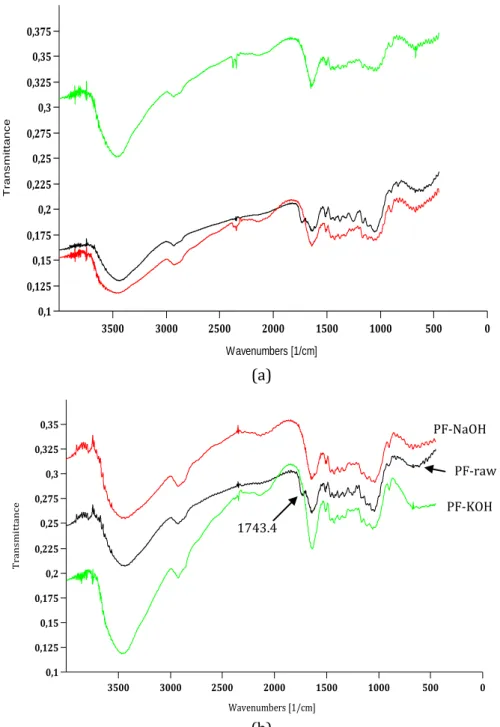
Thermogravimetric analysis
The alkalized NaOH and KOH fibers showed higher degradation temperatures compared to the raw fibers. Compared with NaOH-treated fibers, the thermal resistance of sample PF-KOH is higher than that of PF-NaOH. For the main fiber degradation range 250–310°C, the alkalized fibers had less weight loss than the raw fibers.
These results indicate that alkali treatments removed parts of the hemicellulose and lignin components from the fiber. Because of this, the degradation process took place mainly on the cellulose, which in turn increased the overall degradation temperature of the treated fibers.
Fiber Morphology Analysis
CONCLUSION
Characterization of Musaceae and Saccharum Officinarum Cellulose Fibers for Composite Application
INTRODUCTION
Similarly, NaOH treatment at a concentration of 5% to 15% was proven to increase the ductility and elongation of Borassus fruit fibers [12]. The tensile strength of hemp fiber increased to 65% after treatment with 0.5% NaOH solution for 30 minutes[13]. In addition to NaOH treatment, some studies have also used potassium hydroxide (KOH) treatment to improve the properties of natural fibers.
Previous studies have shown that investigations related to the characterization of natural fibers using NaOH have been widely reported. On the contrary, studies related to the characterization of natural fibers using KOH solutions are still very limited. Considering the potential of Musaceae and Saccharum Officinarum fibers which are abundant, cheap and environmentally friendly; their function as reinforcement in the manufacture of composites needs to be improved.
Fourier Transform Infrared (FTIR) spectroscopy, thermogravimetry (TGA), chemistry and tensile tests were performed to characterize both types of fibers.
MATERIAL AND METHODS 1 Materials
- Fiber Bundles Extraction
- Alkaline Treatment of Fibers
- Physical Properties of Fibers .1 Density
- Fourier Transform Infrared (FTIR) Spectroscopy
- Tensile Strength Properties
- Thermogravimetric
- Scanning Electron Microscope (SEM)
In addition, changes in the surface morphology of both fibers were also analyzed by scanning electron microscopy (SEM). The content of cellulose, hemicellulose and lignin in fiber samples was determined using the standard TAPPI method. BF–NaOH Saccharum Officinarum L NaOH-treated stem fiber BF–KOH Saccharum Officinarum L KOH-treated fiber PF–Crude Musaceae L Stem crude fiber.
The amount of weighed fiber was completely submerged in water and volumetric displacement was observed. The amount of weighed fibers was placed in the oven for 4 hours at a temperature range of 104 ± 2°C. The fiber weight from the oven was measured and the difference in weight takes into account the moisture content in the fiber.
The FTIR used is a Perkin Elmer Spectrum Fourier Transforms infrared spectrometer (Frontier Spectrum model) that has a spectral range of 4000–450 (cm–1) with a resolution of 4 cm–1 and a scan rate of 32 scans per minute. Each fiber sample was tested using an INSTRON 1390 at a constant crosshead speed of 2.5 mm/min and a 10 kN load cell under ambient temperature and 64% humidity conditions. Thermogravimetric analyzes (TGA) of raw and chemically treated fiber samples were performed using a TGA Q500, the TA instrument was under a nitrogen atmosphere.
The surface morphologies of raw PF, raw BF and treated fibers were observed using an FEI model (Inspect-S50 type) SEM operating at 10 kV.
RESULT AND DISCUSSION 1 Chemical Properties of Fibers
During alkaline chemical treatment, the cellulose content of the PF-NaOH and PF-KOH samples increases, whereas the hemicellulose and lignin content of the fiber decreases. The low fiber density shows that the PF and BF fibers had hollow structures (5), as confirmed by the SEM images in the next section. Therefore, raw and treated fibers can be used as a reinforcement to produce lightweight composite structures.
In addition, the low moisture content of chemically treated fibers can provide intermediate strength of the polymer matrix when the fibers are used as reinforcement in polymer composites. a) Strain strain of Musaceae fiber, (b) Strain strain of Musaceae fiber, (c) Strain strain of Saccharum Officinarum fiber, and (d) Strain strain of Saccharum Officinarum fiber. Figure 2(a) shows that after alkali treatment, the tensile strength of the fiber is higher than that of the raw fiber. It was found that the average tensile strength of PF–KOH, PF–raw and PF–.
The average tensile strength of PF-KOH fiber samples is higher than that of other fiber samples studied. The increased tensile strength of the PF-KOH sample is estimated because the fiber diameter is smaller than that of the PF-NaOH and PF raw samples (see Table 2). In contrast, BF-raw gives the highest tensile strength (263.40 MPa) compared to BF-NaOH (255.39 MPa) and BF-KOH (187.77 MPa) (Figure 2c) because after treatment with NaOH and KOH, the cell wall the fibers are damaged by excessive extraction of hemicellulose and lignin.
The SEM images of the surface of the raw and the alkali-treated fibers are shown in Figure 5. The microscopic image showed that the surface of both fibers (BF-raw and PF-raw) has very shallow grooves, fiber, other impurities (see in Figure 5a and 5d), and a number of lumens in the fiber bundles (see in Figure 6a and 6d). With alkali treatment (Figure 5(b, c, e, and f), the white layer decreases and the surface of the fiber sample becomes rougher and fibrillar due to the loss of hemicellulose in the fiber surface.
However, the SEM images also showed that for BF-KOH (Figure 5c) and PF-NaOH (Figure 5e), many cell walls in the fiber were damaged after chemical treatment, resulting in a decrease in fiber strength. In addition, a large number of lumen diameters in KOH-treated fibers and NaOH-treated fibers decrease after alkali treatment (Figure 6(b, c, e and f) below) due to the reduction of hemicellulose. Overall, the properties of these two types of fibers have enormous potential to be redeveloped as fillers in polymer composites.
